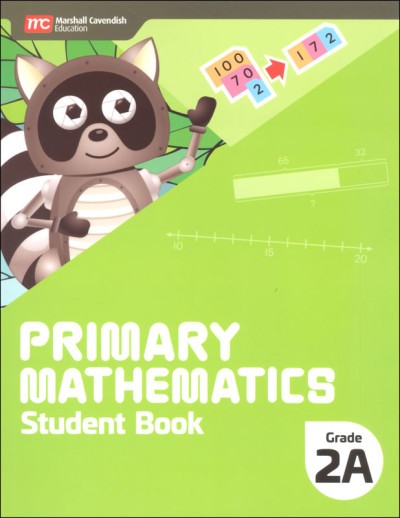We use cookies to make your experience better. To comply with the new e-Privacy directive, we need to ask for your consent to set the cookies. Learn more.
Primary Mathematics Student Book 2A (Revised edition - 2022 Edition)
The colorful and engaging Student Books are consumable. The Grade 2 level has a winsome raccoon mascot. This raccoon critter shows up on all the products for that grade level and inside pages include this critter as well as others.
Although reminiscent of the semester-based textbooks of previous Primary Math editions, these are expanded in terms of instruction as well as included practice exercises. They are not, however, designed to stand alone but to be a tool in the hand of the teacher (parent). Comprehensive instruction is the result of the instructional sequences provided by the teacher coupled with directed questions.
The general appearance of these full-size (8.5"x 11") books is uncluttered, providing room for student work with just enough color and appropriate light-hearted graphics. Pages are perforated. Chapters are initiated with full-page, full-color real-world illustrated story situations. Lessons are “opened" with half-page illustrated “stories."
Instruction in the Student Book follows an Opener – Learn – Practice pattern through the daily lessons and a Recall – Instructional Sections – Performance Task – STEAM Project – Chapter Practice – Chapter Test organization through each chapter. Periodic Think! exercises focus on critical thinking skills and problem solving. The Singapore math basics are obvious throughout the course: start with the concrete, move to pictorial in the Student Book, and morph into abstract.
The Practice on Your Own pages in the Student Book provide practice at the end of each lesson, but these are just the tip of the iceberg in terms of practice and homework options available. After each Section (collection of lessons) there is an exercise assignment available in the Mastery and Beyond book. These exercises are cumulative over several lessons. Differentiated instructional options for each lesson include correlated on-level practice exercises in the Additional Practice book. There is also a Reteach Book, and for those students who need additional challenge, an Extensions Book. These last two are only available as digital versions.
The Student Book is the consumable textbook of the program.Chapters and daily lessons are based on the Readiness-Engagement-Mastery model of learning used in Singapore classrooms. In the Readiness phase, students make connections to previously learned concepts and skills to be sure they have the base knowledge to succeed with learning goals. In the Engagement phase, students learn by doing and construct new knowledge through engaging activities and guided inquiry. In the Mastery phase, students gain fluency, confidence, and deeper conceptual understanding through practice and problem solving.
Note: Two books (A and B) for each grade correspond to the two halves of the school year. Answer key in Teacher's Guide and Home Instructor's Guide.
Concepts covered include: Group objects and numbers up to 1,000 into hundreds, tens, and ones. Use base-ten blocks to create equivalent representations of numbers. Count within 1,000. Count by multiples of ones, tens, and hundreds. Use <, >, and = to compare two 2-digit numbers and write equations for inequalities. Write multi-digit numbers in expanded form. Use place-value models to represent numbers to 1,000. Write numbers to 1,000 in standard, expanded, and word forms. Partition circles and rectangles into unit fractions halves, thirds, and fourths. Identify $1, $5, $10, $20, and $100 bills. Count and make combinations of coins and bills. Solve word problems involving money. Use the dollar sign and decimal point. Model addition and subtraction within 1,000 using place-value strategies. Solve multi-digit addition and subtraction problems by using a bar model. Represent multiplication as repeated addition. Use x and = symbols to represent multiplication equations. Solve multiplication word problems. Solve addition and subtraction word problems involving money. Use mental math strategies to add and subtract. Use the Associative Property, Identity Property, and Commutative Property as addition strategies. Identify odd and even numbers. Recognize how bar models show relationships between numbers and unknowns in number sentences. Use equations to represent real-world problems. Identify lines, curves, triangles, quadrilaterals, pentagons, hexagons, and cubes. Identify, describe, sort, and classify three-dimensional shapes. Demonstrate linear measure as an iteration of units. Estimate and measure length. Solve addition and subtraction word problems involving length. Tell and write time using A.M. and P.M. Tell time to five minutes. Develop foundations for understanding area. Collect and organize data in different ways. Build skills in addition, subtraction, multiplication, and measurement through problem solving. Recognize the relationship between bar models, number sentences, and number patterns. Solve real-world problems involving addition, subtraction, measurement, and data analysis. Consult or download the complete Scope and Sequence for a full report of covered topics and concepts.
| Product Format: | Binder |
|---|---|
| Grade: | 2 |
| Brand: | Marshall Cavendish |
| ISBN: | 9789814911382 |
| Length in Inches: | 10.875 |
| Width in Inches: | 8.5 |
| Height in Inches: | 0.5625 |
| Weight in Pounds: | 1.1875 |


REQUIRED BY SCHOOL
Have done primary mathematics previously but after looking through the new 2022 edition saw that there was greater detail for the instruction of students and a breakdown of scheduling which was appealing.
My son is in second grade and I think he would be easily able to handle this level (he is nine and was just withdrawn from school half way through the year), but I was advised by other parents using…
2nd grade math